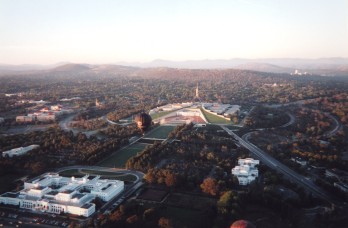| About Mission Members Meetings Publications |
Founding PartnersBrasilia Canberra Ottawa Washington, DC |
Canberra, AustraliaThe National Capital of Australia
The National Capital Authority (NCA)is an Australian Government statutory agency charged with creating a national capital which symbolises Australia’s heritage, values and aspirations, is internationally recognised and worthy of pride by Australians.Its key responsibilities are to:
Planning the CapitalThe NCA is responsible for the development, review and administration of the National Capital Plan, thestrategic plan for Canberra and the Territory to be planned and developed in accordance with their national significance. It is responsible for the planning of all major approach routes and areas of national significance such as Lake Burley Griffin and the Parliamentary Zone, the central national area, the national capital open space system and the inner hills. The legacy of Walter Burley Griffin and Marion Mahony Griffin continues to be a major influence on the future planning and development of the capital. The Griffin Legacy, (a 2004 NCA publication) is the blueprint for future development of Canberra’s central national area in the 21st century. Key components of the Legacy have been incorporated into the National Capital Plan. In the 2006/2007 budget, the Australian Government committed more than $70m for the construction of critical infrastructure to enable implementation of the Griffin Legacy. Over the coming decades, Canberra will see the extension of the city to the lake, revitalisation of the city centre, the linking of the national institutions and reinforcing of the main avenues. Promoting the CapitalA national capital is about more than buildings and places, it is also about what it means in our hearts, our minds and our national psyche. The NCA is developing an understanding and appreciation of the role of Canberra as the national capital. We take a strategic approach to fostering an awareness of the capital by encouraging participation, appreciation and celebration in the capital, through information and education, and by promoting the attributes of Canberra that have national significance.Promoting the CapitalA national capital is about more than buildings and places, it is also about what it means in our hearts, our minds and our national psyche. The NCA is developing an understanding and appreciation of the role of Canberra as the national capital. We take a strategic approach to fostering an awareness of the capital by encouraging participation, appreciation and celebration in the capital, through information and education, and by promoting the attributes of Canberra that have national significance.NCA outreach activities include:
Enhancing the CapitalThe NCA is responsible for ensuring that national public places continue to be created which enrich the experience of Canberra and increase an understanding of and involvement in the capital. Our capacity to advocate and initiate capital works in national public areas is essential to the continued development of the capital for all Australians. Projects in the central national area include:Reconciliation Place This symbolically significant promenade recognises the importance of understanding the shared history of Indigenous and non-Indigenous Australians, and reaffirms our commitment to reconciliation as an important national priority. Reconciliation Place is intended to evolve over time and, only recently, four new art works were installed. Menzies WalkA 2km public promenade is being constructed on the northern shores of Lake Burley Griffin.The RG Menzies Walk reconstruction is the first project in a staged program of works under the Canberra Central Parklands Master Plan. The Walk will provide a well-lit, paved path through Commonwealth Park, Rond Terraces and Kings Park that will maximise the enjoyment of all those wishing to experience of the National Capital’s most beautiful settings. Humanities and Science CampusA campus is under construction linking the National Library and the National Science and Technology Centre buildings and landscape areas; a project which emerged from the Parliamentary Zone Review 2000. The campus will ensure pedestrians can orient themselves in the Zone, move easily between the buildings and view the corridors to the Lake or Parliament House.Maintaining the CapitalThe NCA manages assets of approximately $700 million and 1,095 hectares of land in Canberra. Most of this land is in the public domain of the central areas of the capital and includes some of the nation’s most significant cultural landscapes and national attractions – among them:
|
 Canberra is the national capital of Australia, with a population of over 330,000 people. It is one of Australia’s greatest assets, a world-class city which is home to virtually all the major national institutions and cultural collections. Over ninety countries have diplomatic representation in Canberra to facilitate relationships between governments.
Canberra is the national capital of Australia, with a population of over 330,000 people. It is one of Australia’s greatest assets, a world-class city which is home to virtually all the major national institutions and cultural collections. Over ninety countries have diplomatic representation in Canberra to facilitate relationships between governments.